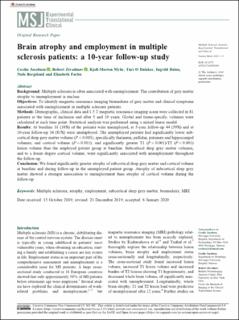| dc.contributor.author | Jacobsen, Cecilie | |
| dc.contributor.author | Zivadinov, Robert | |
| dc.contributor.author | Myhr, Kjell-Morten | |
| dc.contributor.author | Dalaker, Turi Olene | |
| dc.contributor.author | Dalen, Ingvild | |
| dc.contributor.author | Bergsland, Niels | |
| dc.contributor.author | Farbu, Elisabeth | |
| dc.date.accessioned | 2021-07-05T12:21:14Z | |
| dc.date.available | 2021-07-05T12:21:14Z | |
| dc.date.created | 2021-01-21T13:11:46Z | |
| dc.date.issued | 2020 | |
| dc.Published | Multiple Sclerosis Journal, Experimental, Translational and Clinical. 2020, . | |
| dc.identifier.issn | 2055-2173 | |
| dc.identifier.uri | https://hdl.handle.net/11250/2763421 | |
| dc.description.abstract | Background: Multiple sclerosis is often associated with unemployment. The contribution of grey matter atrophy to unemployment is unclear.
Objectives: To identify magnetic resonance imaging biomarkers of grey matter and clinical symptoms associated with unemployment in multiple sclerosis patients.
Methods: Demographic, clinical data and 1.5 T magnetic resonance imaging scans were collected in 81 patients at the time of inclusion and after 5 and 10 years. Global and tissue-specific volumes were calculated at each time point. Statistical analysis was performed using a mixed linear model.
Results: At baseline 31 (38%) of the patients were unemployed, at 5-year follow-up 44 (59%) and at 10-year follow-up 34 (81%) were unemployed. The unemployed patients had significantly lower subcortical deep grey matter volume (P < 0.001), specifically thalamus, pallidus, putamen and hippocampal volumes, and cortical volume (P = 0.011); and significantly greater T1 (P < 0.001)/T2 (P < 0.001) lesion volume than the employed patient group at baseline. Subcortical deep grey matter volumes, and to a lesser degree cortical volume, were significantly associated with unemployment throughout the follow-up.
Conclusion: We found significantly greater atrophy of subcortical deep grey matter and cortical volume at baseline and during follow-up in the unemployed patient group. Atrophy of subcortical deep grey matter showed a stronger association to unemployment than atrophy of cortical volume during the follow-up. | en_US |
| dc.language.iso | eng | en_US |
| dc.publisher | SAGE | en_US |
| dc.rights | Navngivelse-Ikkekommersiell 4.0 Internasjonal | * |
| dc.rights.uri | http://creativecommons.org/licenses/by-nc/4.0/deed.no | * |
| dc.title | Brain atrophy and employment in multiple sclerosis patients: a 10-year follow-up study | en_US |
| dc.type | Journal article | en_US |
| dc.type | Peer reviewed | en_US |
| dc.description.version | publishedVersion | en_US |
| dc.rights.holder | Copyright the authors 2020 | en_US |
| cristin.ispublished | true | |
| cristin.fulltext | original | |
| cristin.qualitycode | 1 | |
| dc.identifier.doi | 10.1177/2055217320902481 | |
| dc.identifier.cristin | 1876543 | |
| dc.source.journal | Multiple Sclerosis Journal, Experimental, Translational and Clinical | en_US |
| dc.identifier.citation | Multiple Sclerosis Journal, Experimental, Translational and Clinical. 2020, 6 (1). | en_US |
| dc.source.volume | 6 | en_US |
| dc.source.issue | 1 | en_US |

